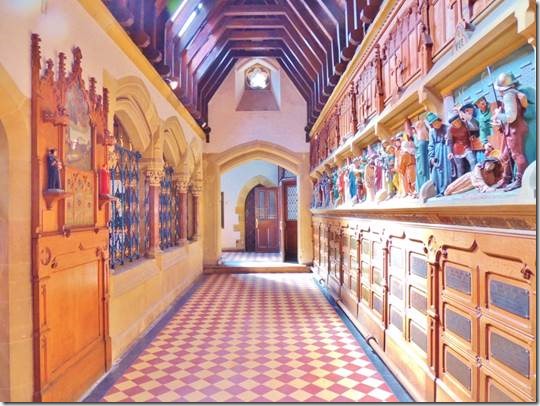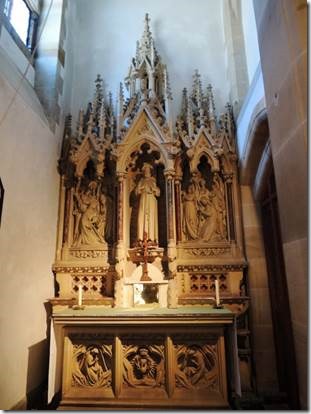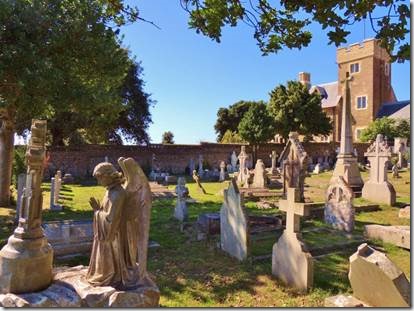Sunday, early evening
Labor Day tomorrow back home
Cheers,
For all of you who had no clue about August Pugin, here’s the story.
Ru
Augustus Charles Welby Pugin
The small office at the Ramsgate Marina had two brochures related to Augustus Pugin, one a Pugin tour of Ramsgate and one devoted to St. Augustine’s Church. When I read that he was one of Britain’s foremost architects, I thought maybe we should make the effort to see the church. Tours were also offered so that would be a plus. On the minus side I failed to read the tours began at 3 PM and we arrived at 2. But no problem, the whole interior of the church was closed so folks could set up for the wedding of some local parishioners. Famous though it might be; it firstly is the church of the people who live in Ramsgate.
We did get to see the “Alois de Beule studio Stations of the Cross which had intrigued me in the brochure because they were so colorful. It was part of the North Cloister. Descriptions with the photos from http://www.victorianweb.org/art/architecture/pugin/31.html
|
Alois de Beule studio Stations of the Cross Part of the long, polychromed terracotta panel depicting the Stations of the Cross, to the design of the Flemish sculptor Alois De Beule, added in 1893. |
|
Detail The clothes of the people look more medieval than biblical to me. |
|
The Altar of the Sacred Heart, designed in neo-Gothic style by Pugin’s youngest child, Peter Paul Pugin. |
|
John Hardman Powell’s delicate fleur-de-lys screen. |
|
The names and dates in the graveyard illustrated the point that the church is still very much used today with very recent additions. |
Augustus Charles Welby Pugin was born in the same year as Charles Dickens and, arguably, did as much to define and shape Victorian Britain, but, by comparison, he is neglected.
Pugin lived for only forty years but during his short life he blazed a trail that is still with us today.
This is the story of a driven, scandalous, genius of a man who was imprisoned for debt, widowed, bankrupted, shipwrecked and eventually confined to Bedlam; but it is also the story of a man who had a vision for Britain and whose life’s work still defines our country today.
In this programme, (A BBC Production that was shown in August ) Richard Taylor restores Pugin to his rightful place as one of the giants of the Victorian age by taking us into his Gothic fantasy land. From the Houses of Parliament to Alton Towers, from thousands of churches throughout the country to the details and furnishings of suburban family houses, Pugin changed the face of Britain with his visionary Gothic architecture. ……
Working – with some difficulty – under Sir Charles Barry, Pugin’s tour de force would be the rebuilding of the Palace of Westminster, exemplified in the dazzling interiors of the House of Lords and the stupendous clock tower which would become famous as the home to ‘Big Ben’. In this magnificent edifice Pugin was creating the ultimate Gothic citadel with its gold turrets, panelling and vaulting, and in the highly wrought, ornate detail that can be found even in the most obscure corners. This is arguably the most English of buildings, tapping into the Romantic English past of knights and chivalry, of peace and prosperity.
Richard also takes us to Pugin’s final home in Ramsgate, which he designed himself, and to St Augustine’s, the church nearby, which he both built and funded and which almost bankrupted him. Even when his faculties were failing him what he created here is pure Pugin. The final detail would come with the addition of a finely wrought medieval tomb – which would be Pugin’s own resting place.
http://www.bbc.co.uk/programmes/p00n58pm
One building stands above all others as a testament to Pugin’s influence, however. The Palace of Westminster (i.e. The Houses of Parliament) in London, was built under the direction of Sir Charles Barry, but Pugin was responsible for the every aspect of the interiors, as well as for creating working drawings of all the exterior details. http://www.britainexpress.com/History/bio/pugin.htm
Pugin’s Church of St. Augustine Ramsgate





